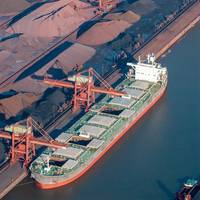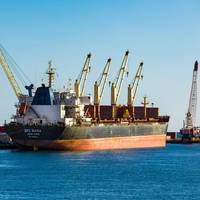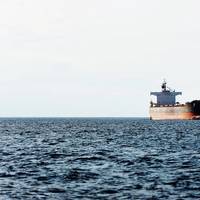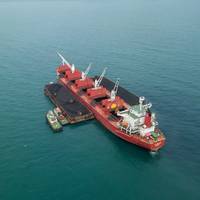Baltic Dry Index Rises to Over Four-month High

The Baltic Exchange's main sea freight index, which tracks rates for ships carrying dry bulk commodities, rose to its highest since mid-May on Monday, supported by gains in the capesize vessel segment.The overall index, which factors in rates for capesize, panamax and supramax shipping vessels, rose 21 points, or 1.3% to 1,614, its highest level since May 10.The capesize index added 65 points, or 3.1% to 2,148, its highest level in over four months.Average daily earnings for capesize vessels…
BIMCO Launches Ship Recycling Film

BIMCO has launched a film calling for the urgent adoption of the Hong Kong International Convention for the safe and Environmentally Sound Recycling of Ships (Hong Kong Convention) and for shipowners to only choose yards that live up to the convention.“Ship Recycling: Time for Change” is partly filmed at ship recycling yards in Alang, India, one of the largest ship recycling nations in the world together with Bangladesh. The film aims to raise awareness among global regulators…
Baltic Dry Index Extends Dip

The Baltic Exchange's main sea freight index fell for a fourth straight session on Tuesday as weakness in Chinese steel consumption took a toll on capesize demand, while rates for other vessel segments also retreated.The overall index, which factors in rates for capesize, panamax and supramax shipping vessels, fell 65 points, or about 6%, to 1,017 points, a more than two-year low.The capesize index fell for the fourth consecutive session, shedding 74 points, or about 18%, to 337 points…
Higher Vessel Rates Lift Baltic Dry Index

The Baltic Exchange's main sea freight index gained to its highest in nearly three weeks on Monday, helped by an uptick in capesize and panamax vessel rates.The overall index, which factors in rates for capesize, panamax and supramax vessels, added 18 points, or 0.7%, to 2,596, a peak since June 1.The capesize index gained 44 points, or 1.47%, to 3,031, the highest since May 26.Average daily earnings for capesizes, which typically transport 150,000-tonne cargoes such as iron ore and coal, rose by $362 to $25,138.Global port congestion is set to continue until at least early 2023 and keep spot
Baltic Index Falls for Fifth Day

The Baltic Exchange's main sea freight index, which tracks rates for ships carrying dry bulk commodities, dropped for the fifth session in a row on Thursday, as rates waned for capesize and panamax vessel segments.The Baltic dry index, tracking rates for capesize, panamax and supramax vessels ferrying dry bulk commodities, fell 70 points, or 4.5%, to a three-week low of 1,470.The capesize index slipped for the sixth session in a row, shedding 200 points, or 9.3%, to a more than five-week trough of 1,945.Average daily earnings for capesizes, which typically transport 150,000-tonne cargoes such
Drewry: Capesize Charter Rates to Go Up
Drewry maintains a positive outlook on the dry bulk market and expects charter rates to improve from current levels, driven by moderate increases in vessel demand and low growth in vessel supply as a result of restrained new ordering and a thin orderbook, according to the latest edition of the Dry Bulk Forecaster, published by global shipping consultancy Drewry.The uncertainty surrounding the dry bulk market, driven by trade wars could, nonetheless, slow down the increase in charter rates. A game of tariffs and counter- tariffs is underway with US at the centre of most of the tussles and it seems unlikely that trade wrangles will end soon.But trade wars might not have a direct negative impact on dry bulk trade.
Upbeat Outlook for Dry Bulk Charter Rates
Drewry expects dry bulk shipping charter rates to recover from the second quarter of 2018 on the back of strengthening Asian iron ore demand, according to the latest edition of the Dry Bulk Forecaster, published by global shipping consultancy Drewry. For the medium and long term, Drewry holds the same views as in previous forecasts. Chinese steel production is expected to pick up pace at the end of winter, in the second quarter of next year, by which time production curbs will have relaxed. Strong infrastructure and construction activities will further strengthen steel consumption. Meanwhile, the Chinese government is closing down inefficient and highly polluting mills…
Improved Demand Easing Dry Bulk Vessel Oversupply
With contraction in vessel supply and healthy demand growth, the dry bulk shipping market is expected to recover from 2017 onwards, according to the latest edition of the Dry Bulk Forecaster, published by global shipping consultancy Drewry. An impressive outlook for dry bulk demand coupled with a small orderbook of newbuilds as a percentage of the total fleet capacity will ensure a sustained recovery in the dry bulk market. Earnings in the dry bulk market are expected to improve from 2017 with a narrowing supply-demand gap. Demand is projected to grow at a healthy pace of 3% while supply is expected to grow by about 1% from 2017, making the dry bulk segment an interesting market to invest in. The growth in demand originates from a rise in iron ore and thermal coal trade.
Pioneer Marine Sink Deeper into the Red
Pioneer Marine Inc. and its subsidiaries (OSLO-OTC: PNRM) ("Pioneer Marine," or the "Company") a leading shipowner and global drybulk handysize transportation service provider announced its financial and operating results for the first quarter ended March 31, 2016. For the first quarter of 2016 the Company reported a net loss of $13.9 million, or $0.46 basic and diluted per share which includes charges amounting to $8.7 million as a result of the termination of five newbuilding contracts (“newbuilding contract termination agreement”). Excluding these charges, the Company’s adjusted net loss for the first quarter of 2016 is $5.3 million or $0.17 per share basic and diluted. As of March 31, 2016, the Company had cash and cash equivalents of $43.8 million and restricted cash of $12.5 million.
Iron Ore Industry Wavers between Hope and Reality
If the price of the product your company produced had just experienced a 20 percent price surge in one day, its biggest jump ever, it would be reasonable for you to be overjoyed. But maybe not if you are an iron ore miner. This month's leap in Asian spot iron ore prices coincided with the annual Global Iron Ore and Steel Forecast conference in Perth, capital of Western Australia state and home to the iron ore operations of three of the world's four biggest producers. Spot iron ore soared to $62.60 a tonne on March 7 from a prior close of $52.40, a record in percentage terms and the biggest dollar move in four years. The problem for the insiders at the Perth conference is that as much as they would like to believe the move is sustainable, nobody really does.
Miserable Start for Dry Bulk Shipping
The global production of steel dropped in 2015 compared to 2014, to a larger extent outside China, as China exported its surplus of steel to destinations across the globe; it is too complex to single out whether this is positive or negative for the seaborne dry bulk transport demand, says BIMCO. Going forward, the Chinese steel industry is set to grow its global market share, currently at 50%. Depending on domestic steel consumption in China, use of domestically mined iron ore and profitability in the steel industry, the dry bulk market will be impacted. Chinese steel prices have risen since mid-December and currently, sit at the highest level since October 2015. International iron ore prices could slide further during 2016 as supply exceeds demand.
Steel Prices Stay Firm
With global steel demand running at an unprecedented level, rapidly rising prices have been a constant headache for ship repairers, as well as ship builders, in recent months. And despite sharply higher steel output, there is little sign of any softening as the New Year dawns. According to the International Iron and Steel Institute (IISI), crude steel production for the 62 countries reporting their figures was 945m tonnes by the end of November, up 9% on the corresponding period one year earlier. Analysts were expecting total production to break through the billion tonne mark easily by the end of the year for the first time ever. IISI figures show that China accounted for the largest increase in output.
World Industry Drives Freight Rates Up
In 2000, freight rates turned out at a significantly higher level than during the previous year. On an average basis, tripcharter rates for Capesizes (150,000 dwt) more than doubled to $17,600/day, while rates for modern Panamaxes increased from $7,500 to $11,100/day. For Handymaxes, tripcharter rates went up from $6,900 to $9,200/day. The freight market showed a steady rise through the first three quarters of the year, but softened somewhat during its final three months. The main cause of the firmer freight market was the strong upturn in world economic growth, and particularly in the U.S. The strong U.S. economy combined with imports of finished goods created strong support for industrial production in and exports from the rest of the world.





